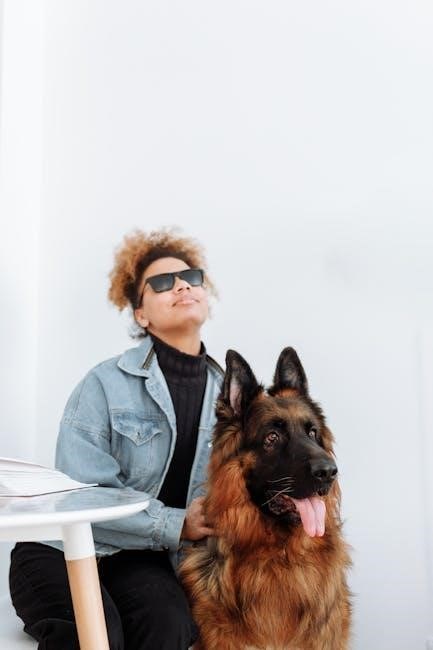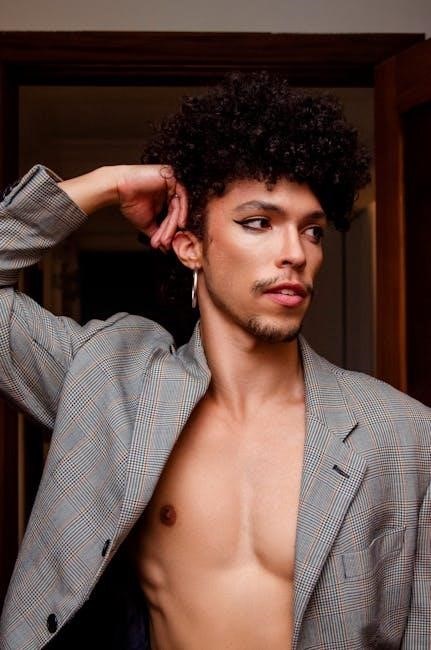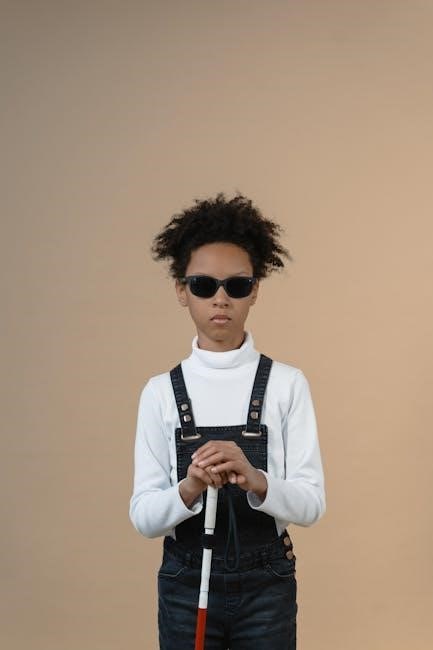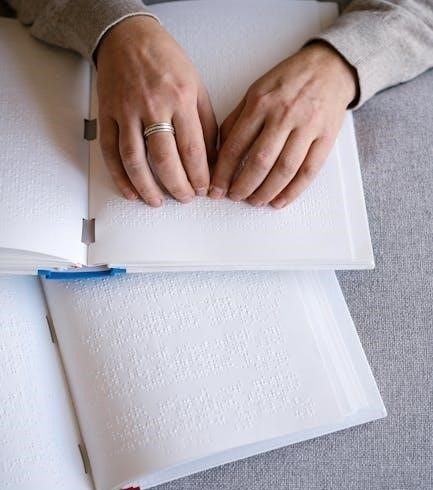Welcome to the Ultimate Hair Guide, your comprehensive resource for understanding and enhancing your hair. Discover tips on hair care, styling, and maintenance tailored to your unique needs.

Understanding Your Hair Type
Understanding your hair type is the foundation of effective hair care. From straight to curly, each type has unique characteristics that influence styling, product selection, and maintenance routines.
2.1. Identifying Your Hair Type
Identifying your hair type is crucial for personalized care and styling. Hair types are generally categorized as straight, wavy, curly, or kinky, with subcategories based on texture and curl pattern. The hair typing system (1-4) helps classify hair further, with 1 being straight, 2 wavy, 3 curly, and 4 tightly coiled. To determine your type, examine your hair’s natural texture when wet, as this reveals its true curl pattern. Straight hair lacks curls, while wavy hair has subtle bends. Curly hair forms defined spirals, and kinky hair has tight, zig-zag patterns. Understanding your type helps you choose the right products, techniques, and styles. For example, curly hair benefits from moisture-rich products, while straight hair may need lightweight formulas. Knowing your hair type ensures better manageability and enhances its natural beauty.
2.2. The Importance of Hair Texture
Hair texture plays a significant role in determining your hair’s behavior and needs. Texture refers to the diameter of each hair strand, categorized as fine, medium, or thick. Fine hair is lightweight and may lack volume, while thick hair is coarse and more prone to frizz. Understanding your texture helps you choose the right products and techniques. For instance, fine hair benefits from lightweight, volumizing formulas, while thick hair requires moisturizing products to prevent dryness. Texture also influences styling options; fine hair may not hold bold styles well, whereas thick hair can handle layered cuts and bold textures. Recognizing your hair’s texture ensures you adopt a tailored care routine, enhancing manageability and promoting healthy, vibrant hair.
2.3. Understanding Hair Porosity
Hair porosity refers to your hair’s ability to absorb and retain moisture, a critical factor in determining its health and manageability. It is categorized into low, medium, and high porosity. Low porosity hair has a compact cuticle layer, making it resistant to moisture absorption, often leading to dryness and product buildup. Medium porosity hair balances absorption and retention well, while high porosity hair has a lifted cuticle, absorbing moisture quickly but losing it just as fast, resulting in frizz and dullness. Understanding your hair’s porosity helps you choose the right products and techniques. For low porosity, lightweight, water-based products work best, while high porosity hair benefits from deep conditioning treatments and humidity-fighting products. Balancing porosity ensures your hair stays hydrated, shiny, and resilient.

Choosing the Right Hairstyle
Hair porosity determines how well your hair absorbs and retains moisture. It’s categorized into low, medium, and high porosity. Low porosity hair has a compact cuticle, resisting moisture and causing dryness. Medium porosity hair absorbs and retains moisture effectively, while high porosity hair absorbs quickly but loses moisture fast, leading to frizz. Understanding your hair’s porosity helps tailor care routines, ensuring proper hydration and minimizing damage. Lightweight products suit low porosity, while deep conditioning benefits high porosity. Balancing porosity enhances hair health and appearance.
3.1. Determining Your Face Shape
Identifying your face shape is crucial for selecting a flattering hairstyle. Common face shapes include oval, round, square, heart, and diamond. Measure your facial dimensions to determine your shape: width of the forehead, cheekbones, and jawline. For an oval face, the length is 1.5 times the width. A round face has equal width and length, while a square face has a strong jawline. Heart-shaped faces have a wider forehead and narrower chin, and diamond faces feature narrow foreheads and wide cheekbones. Use a mirror or photo to analyze your features. Understanding your face shape helps guide hairstyle choices, ensuring a balanced and harmonious look. This step is essential for finding styles that complement your natural proportions and enhance your appearance.
3.2. Popular Hairstyles for Different Face Shapes
Choosing a hairstyle that complements your face shape can enhance your features and create a balanced look. For oval faces, most styles work well, but side-swept bangs and shoulder-length cuts are particularly flattering. Round faces benefit from styles with height, such as pompadours or long layers, to elongate the silhouette. Square faces look great with soft, layered cuts or wispy bangs to soften strong angles. Heart-shaped faces are flattered by styles with volume at the jawline, like chin-length bobs or side-swept bangs. For diamond faces, angled cuts and side-swept bangs highlight cheekbones. Understanding your face shape allows you to narrow down hairstyles that will enhance your natural beauty and create a harmonious balance.
3.3. Considering Hair Type and Lifestyle
Your hair type and lifestyle play a crucial role in determining the best hairstyle for you. For instance, curly hair benefits from styles that enhance natural texture, while straight hair may require layers for volume. If you have a busy schedule, low-maintenance styles like undercut or pixie cuts are ideal. For those with thick hair, avoid heavy, bulky cuts that can overwhelm the face. Fine hair looks best with light layers or side-swept bangs to create the illusion of thickness. Consider your daily routine, profession, and personal preferences when choosing a hairstyle. A style that fits your lifestyle ensures ease of maintenance and confidence. Consulting a stylist can help tailor a look that balances your hair type, face shape, and daily commitments for a seamless, flattering result.

Hair Care Routines
A proper hair care routine involves consistent cleansing, conditioning, and protection. Shampoo based on hair type, use conditioner for moisture, and avoid hot water. Limit heat styling tools and opt for nourishing masks to maintain healthy locks.
4.1. Daily Hair Care Tips
Effective daily hair care is essential for maintaining healthy and vibrant locks. Start with gentle shampooing, using a formula suited to your hair type. Condition thoroughly, focusing on ends to prevent split ends. Avoid hot water, as it strips natural oils; opt for warm or cool water instead. Gently blot excess moisture with a microfiber towel to minimize breakage. Reduce heat styling and use a heat protectant spray when necessary. Incorporate a leave-in conditioner or hair serum to add moisture and shine. Avoid tight hairstyles that cause tension, and trim split ends regularly. Finally, protect your hair from UV damage with a hat or SPF-infused products. Consistency in these habits will keep your hair strong, silky, and looking its best.
4.2. Step-by-Step Hair Care Routine
A well-structured hair care routine ensures healthy, manageable hair. Begin with gentle shampooing, massaging your scalp to remove impurities without stripping natural oils. Rinse thoroughly with warm water, then apply conditioner from mid-lengths to ends. Leave it on for 1-2 minutes before rinsing with cool water to seal the cuticles. Gently blot excess moisture with a microfiber towel to avoid friction. Apply a leave-in conditioner or hair serum for added moisture and protection. For styling, use a wide-tooth comb or a detangling brush to minimize breakage. If heat styling, always use a heat protectant spray. Finish with a light-hold hairspray for long-lasting results. Repeat this routine 2-3 times weekly, adjusting based on your hair type and lifestyle for optimal care.
4.3. Common Mistakes to Avoid
When caring for your hair, avoiding common mistakes is crucial for maintaining its health and appearance. Over-washing is a frequent error, as it strips natural oils, leading to dryness and damage. Using excessive heat without a protectant can cause irreversible harm. Towel-drying roughly can create friction, resulting in breakage. Neglecting regular trims allows split ends to spread, damaging the entire strand. Using the wrong products for your hair type can weigh it down or fail to moisturize. Brushing wet hair increases breakage, so opt for a wide-tooth comb instead. Avoid tight hairstyles that cause tension and hair loss; Skipping conditioner can leave hair brittle and prone to tangles. By steering clear of these mistakes, you can preserve your hair’s health and achieve the desired look effortlessly.
4.4. The Importance of Hydration for Hair
Hydration is essential for maintaining healthy, vibrant hair. Just like skin, hair needs moisture to stay soft, shiny, and resilient. Without proper hydration, hair can become brittle, dry, and prone to breakage. Drinking plenty of water is the first step, as it nourishes hair from the inside out. Additionally, using hydrating shampoos, conditioners, and masks helps lock in moisture. Avoiding excessive heat styling and harsh chemical treatments also preserves hair’s natural hydration. Regular trims can prevent split ends, which often result from lack of moisture. For curly or dry hair, deep conditioning treatments are especially beneficial. By prioritizing hydration, you can achieve stronger, more manageable hair that looks and feels its best. Remember, consistent hydration is key to maintaining your hair’s health and appearance.

Hairstyling Techniques and Products
Mastering hairstyling techniques and selecting the right products can transform your look. From blow-drying to curling, techniques vary based on hair type and desired style. Products like shampoos, conditioners, and styling creams enhance texture and hold. Heat protectants are essential for styling tools, while serums add shine. Experiment with products to find what suits your hair best for a polished, professional finish.
5.1. Popular Hairstyling Techniques
Popular hairstyling techniques include blow-drying for smoothness, curling for waves, and braiding for intricate designs. The Curly Girl Method enhances natural textures, while updos like buns and ponytails offer versatility. Smoothing and straightening create sleek looks, while textured volume adds bounce. Messy, undone styles are trendy and easy to achieve. These techniques cater to various hair types and lifestyles, helping you achieve your desired aesthetic. Experiment with tools like flat irons, curling irons, and brushes to master these styles. Whether you prefer sleek sophistication or effortless charm, the right technique can elevate your hair game.
5.2. Essential Products for Different Hair Types
Choosing the right products is crucial for maintaining healthy and styled hair. For straight hair, lightweight shampoos and conditioners prevent oil buildup, while smoothing serums reduce frizz. Curly hair benefits from sulfate-free cleansers, leave-in conditioners, and curl activators to enhance definition. Wavy hair thrives with texturizing sprays and beachy wave creams. For dry or damaged hair, deep conditioning masks, argan oil, and hydrating leave-in treatments are essential. Colored hair requires color-protecting shampoos and toning masks to maintain vibrancy. Thinning hair can be supported with thickening shampoos and scalp serums. Always select products formulated for your specific hair type to ensure optimal results and long-term hair health.
5.3. How to Choose the Right Styling Products
Selecting the right styling products depends on your hair type, lifestyle, and desired look. For moisturizing, opt for hydrating creams or oils. Volumizing products like mousses or root sprays are ideal for thin or limp hair. Sleek styles require smoothing serums or pomades to reduce frizz. Always read ingredient labels and avoid harsh chemicals. If you have color-treated hair, choose color-protecting products. For curly hair, look for curl-enhancing gels or leave-in conditioners. Test samples to ensure compatibility with your hair texture. Consulting a stylist can provide personalized recommendations. Remember, the right products enhance your hair’s natural beauty and longevity, ensuring a flawless finish every time.

Hair Color and Treatment
Explore the world of hair color and treatments to enhance your look. Learn about permanent, demi-permanent, and toners, plus tips for maintaining vibrant, healthy hair.
6.1. How to Choose the Right Hair Color
Choosing the right hair color involves considering your skin tone, natural hair color, and personal style. Cool tones suit pale skin, while warm tones complement olive or dark skin. Test strands before committing to a color. Consider maintenance needs: permanent colors last longer, while demi-permanent colors fade gradually. Think about your lifestyle and how often you can touch up roots. If unsure, consult a professional stylist who can recommend shades that enhance your features. Your hair color should reflect your personality and complement your overall aesthetic. Remember, the right shade can boost confidence and transform your look entirely. Always follow proper application techniques and use quality products to achieve desired results.
6.2. Understanding Permanent vs. Demi-Permanent Colors
Permanent and demi-permanent hair colors differ in their formulation and effects. Permanent hair color penetrates the hair shaft, altering its natural pigment and providing long-lasting results. It can lift or deposit color significantly, making it ideal for drastic changes. However, it may cause more damage due to the use of ammonia and developers, which can dry out the hair over time. Touch-ups are often needed to maintain the color, especially as roots grow out.
Demi-permanent color, on the other hand, does not penetrate as deeply and does not alter the hair’s natural pigment as drastically. It coats the hair shaft, enhancing or depositing color without the use of ammonia, making it a gentler option. This type of color typically lasts for 4-6 weeks and fades gradually, reducing the need for frequent touch-ups. It is often recommended for those looking to enhance their natural color or try a new shade without long-term commitment. Both options have their benefits and drawbacks, and the choice depends on individual preferences and hair care goals.
6.3. Hair Color Maintenance Tips
Maintaining your hair color requires consistent care to preserve vibrancy and prevent fade. Start by using sulfate-free shampoo and conditioner, as they gently cleanse without stripping color. Avoid hot water, opting for cool or warm rinses to seal the cuticle and lock in pigment. Limit sun exposure, as UV rays can dull color; use a hat or color-protecting spray when outdoors.
Touch-ups are essential for maintaining your desired shade. Schedule regular appointments with your stylist to address root growth and tone corrections. At home, incorporate color-depositing masks or toners to refresh your hue between salon visits. Avoid using heat styling tools excessively, as they can damage the hair and cause color to fade faster. By following these tips, you can keep your hair color looking fresh and vibrant for longer.
6.4. The Role of Hair Toner and Masks
Hair toner plays a crucial role in enhancing and maintaining your hair color. It adjusts the tone, neutralizes unwanted shades, and adds vibrancy. Toners are typically applied after coloring to refine the final result and can be used periodically to refresh the color. They are especially useful for achieving subtle, nuanced shades like ash or platinum blondes.

Hair masks, on the other hand, are deep conditioning treatments that repair and nourish your hair. They are essential for colored hair, as they help lock in the color and restore moisture lost during the dyeing process. Use a color-protecting mask once a week to maintain vibrancy and prevent fade. Combine toners and masks for a routine that preserves your hair’s health and color integrity, ensuring your locks stay radiant and resilient.

Finding the Right Hairstylist
Researching and finding a skilled hairstylist is key to achieving your desired look. Read reviews, ask for referrals, and consult portfolios to ensure they match your style preferences.
7.1. Tips for Selecting a Good Hairstylist
Choosing the right hairstylist is crucial for achieving your desired look. Start by asking for referrals from friends or family members with similar hair types or styles. Read online reviews to assess their reputation and expertise. Check their portfolios to ensure their work aligns with your preferences. During your first consultation, discuss your lifestyle, hair type, and face shape to ensure they understand your needs. A good stylist will listen to your ideas while offering professional advice. Additionally, observe the salon’s cleanliness and atmosphere to ensure it meets your standards. Don’t hesitate to ask questions about their experience with your specific hair concerns. Finding a stylist who communicates well and understands your vision is key to a successful hair transformation.
7.2. Questions to Ask Your Barber or Stylist
Effective communication with your barber or stylist is key to achieving the look you desire. Start by asking about their experience with your specific hair type and face shape. Discuss the length and style you prefer and seek their professional opinion on what would work best for you. Inquire about their approach to maintaining your hair’s health, such as avoiding heat damage or using the right products. Ask if they can provide styling tips for at-home maintenance. If you’re considering a significant change, request a visual representation or examples of similar styles they’ve done. Lastly, clarify their policy on follow-up adjustments to ensure you’re satisfied with the final result. Open dialogue ensures a personalized and successful experience.
7.3. How to Prepare for a Salon Visit
Preparing for a salon visit ensures a smooth and successful experience. Start by researching the salon and stylist to ensure they specialize in your hair type and desired style. Bring reference photos of hairstyles you like to communicate your vision clearly. Arrive with clean, product-free hair to allow your stylist to assess your hair accurately. Be prepared to describe your lifestyle and preferences, such as how much time you spend on styling. If you have specific concerns, like hair damage or color correction, mention them upfront. Arrive 10-15 minutes early to complete any necessary paperwork. Finally, be open to professional advice—your stylist may offer valuable insights to enhance your look. Proper preparation ensures you leave satisfied and confident in your new style.



